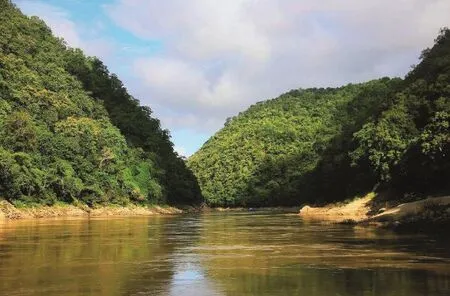Power Station Construction a Boon for Myanmar People
2016-09-26ByGaoXin
By Gao Xin
Power Station Construction a Boon for Myanmar People
By Gao Xin

The proposed location of the Mong Ton Hydropower Station in Myanmar's northern Shan State.
On February 29, 2016, in Naypyidaw, the Myanmar Ministry of Electric Power and China Three Gorges Corporation(CTG) signed a memorandum of understanding for a wind power project in Myanmar's Chaungtha. Tis project, the frst of its kind in Myanmar, has been cited by both governments as the example of bilateral cooperation in electricity production. The Chaungtha power project will help promote development of Myanmar's clean and renewable energy, a project undertaken to help meet local people's growing need for power.
Tis is just one of the projects CTG has undertaken in the feld of clean and renewable energy cooperation in Myanmar.
Power shortages have long held back Myanmar's economic development. According to survey statistics, only 26 percent of Myanmar people have access to reliable power and the problem is even more pronounced in the scorching summer. Yangon is Myanmar's economic center, but blackouts occur frequently and can last for several days, forcing many businesses and even households to install compact generators to meet their electricity needs.
CTG, the largest hydroelectric power corporation in the world, has formidable financial strength and strong experience in planning, designing, building and managing clean energy projects. It has been successfully engaging in cooperation with Myanmar in developing hydroelectric and wind power and other green projects in the country.
In addition to eforts made to help develop wind power in Myanmar, the Corporation was invited by the Myanmar Government in 2010 to work with Tailand and Myanmar to build the Mong Ton Hydropower Station in Myanmar's northern Shan State.
“This will help drive regional economic development, improve the regional environment and benefit regional migrants,” said Mr. Yuan Zhimao, Vice President of China Three Gorges International Corporation(CTGI), who has been involved from the beginning of the project. “Tis is the concept we uphold in China and abroad.”
Environmental Impact
Showing respect for, complying with and protecting nature call for special eforts to stress project quality and safety. It is also vital to pay close attention to the impact on regional economy, protection of local environment, and always putting first the interests of people set to be displaced by the project. According to Yuan, in order to reduce the environmental and social impact, Mong Ton hydropower project will follow recommendations set in Environmental Impact Assessment (EIA) reports and feasibility studies. Changes may include altering the height of the dam or reducing potential water displacement. Adhering to studies' findings can reduce environmental and social impact of the project by more than 50 percent.
“The optimization scheme is the embodiment of our concept for hydropower development,” Yuan said. “We have in mind the comprehensive interests of the country where the project is located, instead of our own interests in recouping the investment. This means we will do our utmost to minimize its impact on local society and environment.”
Yuan explained that in a project of this size, honesty is always the key.
“Being open and transparent is the principle we uphold in the undertaking of the project from beginning to the end,” Yuan said.
In accordance with Myanmar's environmental laws, the Snowy Mountains Engineering Corporation (Australia) was chosen as a third party to carry out the EIA work. All EIA work is done strictly following the guidelines of Asian Development Bank, as well as the regulations of the Ministry of Environmental Conservation and Forestry of Myanmar. Yuan said that local government and local citizens have been informed of every aspect of the project.
“We have created a website through which we release many diferent types of information related to the project,” Yuan said.
The power generated by the project will be used to help ease power shortages in Myanmar and support the state power grid.
In addition, the excess power is expected to help increase tax revenues, and free power allocations and performance shares will beneft the Myanmar government and local governments to share the revenue of power stations, a boon for the country's economic and social development.
The Mong Ton Hydropower Station project was born from eforts of international cooperation. It is expected to boost power cooperation within the Lancang-Mekong River region and in the Mekong River Subregion, and promote communication and information exchange among the China-ASEAN Power Grid. It is widely expected to promote economic development in the Mekong River Sub-region.
Fulfll Its Social Responsibility
Myanmar suffered from serious floods in the summer of 2015, and the middle and lower reaches of the Irrawaddy River were badly affected. Invited by the Myanmar Government, CTG organized a number of industry experts to direct disaster relief work and play a decisive role in coping with food devastation and food control.
Power system planning has an important role to play in the economies of various countries. Due to the need for a highly efcient and stable operation of power systems in Myanmar, CTG provided Myanmar with aid totaling US$3.8 million.
Chinese project members offered the Myanmar power grid overall planning as well as a package scheme for the power grid, and provided the Myanmar Government with reliable data for power grid construction.
In order to improve the technical skills of the engineers of the Myanmar Ministry of Electric Power, Chinese experts held three training classes in Myanmar. Several engineers were sent to Kunming Engineering Corporation Limited for further training.
“China has an old saying: ‘To teach a person how to fish rather than giving them fish',”Yuan said. “It is our hope that Myanmar engineers will emerge [from their training] to better serve the Myanmar power industry.”
According to Mr. He Yonggang, an administrator at the Mong Ton Work Office of CTGI, “long-term cooperation, local integration, balance of agglomeration, mutual beneft and win-win result” are the key principles in a project of this size. He, who is responsible for on-site work, explained the Mong Tong project has not yet entered the implementation stage and he and his staff are currently conducting the cost feasibility studies. Part of this work involves asking the opinions of local people.
“Every time when we do the feld work, we bring with us school bags, stationery and sports supplies and donate them to local schools,” He said. “We will also do our best to help solve problems facing local school teachers. While on our way to the feld work site, we donate clothes and medicines to them, and help repair family or village water facilities with pipes or pumps we bring ourselves.”
Te project also represents employment opportunity to those in the region.
“When we need to employ workers, local people come first,” He said. “They will be organized to receive technical training until they are qualified. Once employed on-site, local workers enjoy the same medical treatment as the Chinese engineers.”
He also said Chinese and Myanmar workers exchange of blessings during China's Lunar New Year and the Water Spring Festival of Myanmar.
“When the project starts construction, we will employ as many Myanmar workers as it takes to improve the standard of living of the local people,” He said. “Meanwhile, we'll do our best to improve transportation, accommodation, communication, schools, hospitals and other infrastructure.”
He pledged: “We will actively perform our corporate social responsibility and carry out public welfare, so as to make more contribution to the development of local society.”
杂志排行
China Report Asean的其它文章
- My 10 Months in Peaceful Yangon
- Yangon's Golden Pagoda A Magnifcent Tribute to Buddha
- Drama Depicts Ancient China-Myanmar Friendship
- Buddhist Exchanges Key to Mutual Understanding
- Hydropower Projects Illuminate Both Sides of the Irrawaddy River
- Students on the Forefront of Friendship-Boosting Cultural Exchanges
